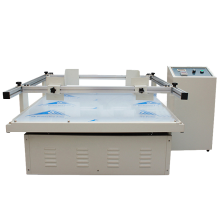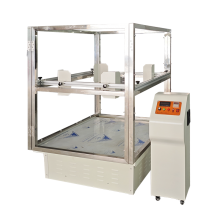| Item | DR-B216 |
| Max. Test Load | 100kg |
| Frequency Range | 60-300rpm |
| Amplitude Range | 25.4mm (1 inch) |
| Simulation Speed | 25~40km/h |
| Vibration Mode | Roundtrip |
| Work Table Size | 1000*1200 mm ( L*W, can be customized ) |
| Outside dimension ( L*W*H ) | 1255*1070*660mm |
| Speed Mode | DC converter or AC Frequency Control |
| Power Capacity | 1 HP |
| Weight | 150kg |
| Power | 220V, 50 Hz |
| Speed Mode | DC converter or AC Frequency Control |
| Environmental Conditions | Temperature: 5~40°C; Related Humidity<85% |
Simulated Transportation Shaker Working Principle and Product Function
Principle of operation
The working principle of a Transportation Shaker is to simulate different transportation conditions by generating vibrations of a specific frequency and amplitude on a mechanical device-driven platform. These vibration environments are generally categorized into constant vibration (e.g., continuous sine wave vibration) and random vibration (e.g., complex vibration patterns of varying frequency and amplitude during transportation). Specifically, the equipment utilizes eccentric bearings driven by a rotating motor to produce an elliptical trajectory to simulate the vibration and impact phenomena during automobile or ship transportation. The vibration test platform is mounted on the eccentric bearing, when the eccentric bearing rotates, the whole plane of the test platform will produce an elliptical up-and-down back-and-forth motion, and the adjustment of the eccentric shaft along with the rotation speed is equivalent to the adjustment of the traveling speed of the automobile or ship.
Product Functions
The simulated transportation shaker has the following main functions:
Simulate different transportation vibration conditions:
By adjusting the frequency, amplitude and time of vibration and other parameters, it simulates the vibration environments that products may encounter in cars, trains, ships and other means of transportation.
Evaluate the stability of packaging and products:
Through vibration testing, assess the vibration resistance of packaging materials and designs, as well as the stability and durability of products in vibration environments.
Verify the rationality of transportation solutions:
By simulating the vibration environment and testing the impact of different transportation solutions on products, we help companies optimize the transportation process and cost.
High precision control:
Modern transportation simulation shakers commonly use advanced control systems that enable precise setting and adjustment of vibration frequency, duration and other parameters. This high-precision control ensures the accuracy and repeatability of test results, providing a reliable basis for product quality assessment.
Wide applicability:
It supports the placement of products of various sizes, and by adjusting the size and shape of the table, it can meet the testing needs of products of different specifications. This makes the simulated transportation shaker widely used in many fields such as electronic products, furniture, ceramics, communication equipment and so on.
Safe and Reliable:
Designed with overload protection, emergency stop and other safety mechanisms to ensure the safety of personnel and equipment during the testing process. In addition, the shaker is also equipped with aluminum guardrails and vibration frequency speed limit protection, further improving the safety of test operations.
Green energy saving:
Optimize the shaker's energy use efficiency to reduce energy consumption and noise pollution. Modern transportation simulation shakers are commonly designed with low noise and energy consumption to meet both testing needs and environmental requirements.
Meet international standards:
Simulated transportation shakers are designed and operated in accordance with international standards such as ISO, ASTM, ISTA, etc., helping companies to meet the quality requirements of the global market.
Technical parameters
The technical parameters of an analog transportation shaker may vary from manufacturer to manufacturer and model to model, but typically include the following:
Running speed: typically 120-300RPM (revolutions per minute), some models up to 100-300RPM (revolutions per minute).
Speed display accuracy: 1RPM (revolutions per minute).
Vibration mode: Reciprocating (running type).
Amplitude: Generally 25.4mm (1 inch).
Effective table surface: Depending on the model, the size of the effective table surface varies, such as 1.0 x 1.0m (L x W), etc.
Time setting range: Generally 0 seconds to 99 hours or 0.1 seconds to 300 hours.
Motor power: The motor power varies according to the model, such as 1HP, 2HP, 3HP, etc.
Application Areas
Simulated Transportation Shakers are widely used in many industries to test the vibration of products during transportation, such as bumps and collisions, in order to evaluate the transportation resistance of products and the reasonableness of packaging design. The main application areas include:
Electronic products: testing the shock resistance of cell phones, tablet PCs, laptops, etc. during transportation and the solidity of internal connectors.
Automobile manufacturing: testing the durability and reliability of automobile parts under different road conditions.
Furniture & Household Goods: Evaluate the damage of furniture and household goods during transportation and optimize the packaging design.
Ceramics and glass products: simulate the vibration and collision environment during transportation to assess the breakage resistance of fragile products.
Toys, gifts, packaging and other industries: test the durability and stability of products during transportation to ensure that they remain intact when they reach the consumer.
Aerospace: Test the parts and overall structure of aircraft, rockets, satellites and other equipment to ensure that they can withstand great vibration and impact without damage during launch, flight and recovery.
Defense industry: Strict vibration testing of military equipment and components to ensure their reliability and safety in complex environments.
Communication equipment: assessing the stability and reliability of communication equipment during transportation to ensure that it will not suffer from performance degradation or damage during transportation.

Send Inquiry to This Supplier
You May Also Like
-
Tear Strength Tester for Textile/Film - ASTM D1424 & ISO 13937 CertifiedUS$ 2000 - 3000MOQ: 1 Set
-
Digital Tear Tester for Plastic Packaging - 0-100N Range ±0.1% AccuracyUS$ 2000 - 3000MOQ: 1 Set
-
Industrial Tear Tester for Corrugated Paperboard - 200mm/s Test SpeedUS$ 2000 - 3000MOQ: 1 Set
-
Bulk Discount! Tear Strength Testers for Global Packaging SuppliersUS$ 2000 - 3000MOQ: 1 Set
-
Textile Fabric Tear Strength Test Equipment Automatic Paper Strength Elmendorf Tearing TesterUS$ 2000 - 3000MOQ: 1 Set
-
Elmendorf Method Paper Tearing Strength TesterUS$ 2000 - 3000MOQ: 1 Set
-
Multi-Material Tear Tester (Plastic/Rubber/Paper)US$ 2000 - 3000MOQ: 1 Set
-
Fabric Tear Resistance Meter Electronic Textile Paper Elmendorf Tearing Strength TesterUS$ 2000 - 3000MOQ: 1 Set
-
Elmendorf Tearing Strength Tester ISO 1974 ASTM D1922 D1424 for Testing Fabric Tear ResistanceUS$ 2000 - 3000MOQ: 1 Set
-
Elmendorf Tear Film Strength Digital Resistance Paper Tearing Machine Test Tester Equipment TestingUS$ 2000 - 3000MOQ: 1 Set












